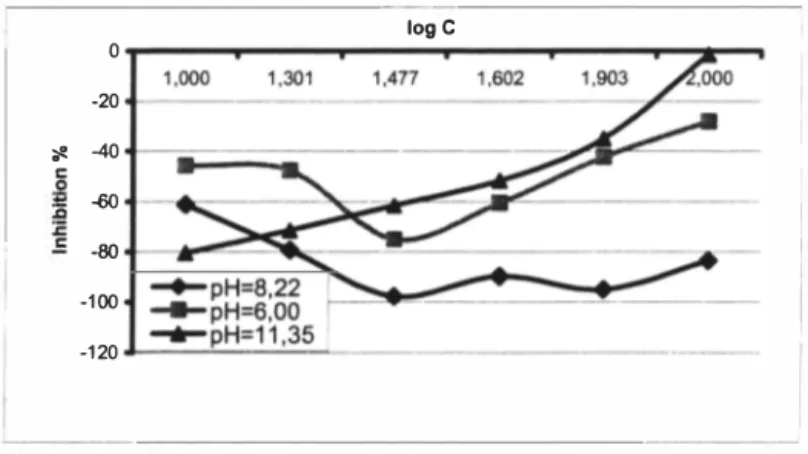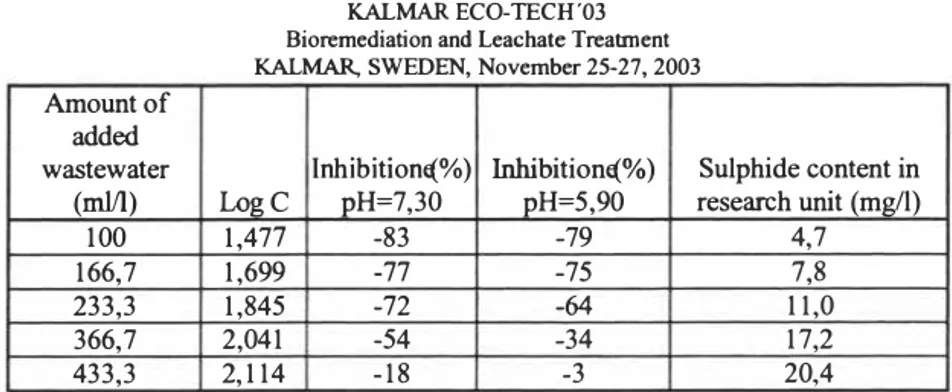Bioremediation and Leachate Treatment KALMAR, SWEDEN, November 25-27, 2003
SULPHIDE FORMATION IN SEWAGE PIPES
AND INFLUENCE OF H2S TO AEROBIC
ACTIVATED SLUDGE MICROORGANISMS
Kristo Karmas Toomas Tenno Karin He/lat University of Tartu, Estonia ABSTRACTThe object of this work is to research the sulphide formation process in pressure pipes and how the sulphur rich wastewater influences treatment process in Kohtla-Jiirve wastewater treatment plant (WWTP),
In this work the ISO 8192 standard test has been used to estimate the inhibition of oxygen demand of activated sludge microorganisms in different sulphide concentrations and pH values, Two wastewaters has been investigated - leachate from coke- and ash hills and wastewater from inflow ofKohtla-Jii.rve WWTP,
The leachate from coke- and ash hills, rich of sulphates and sulphides, with high pH values from l O+ 12, did not cause significant inhibition of oxygen demand of activated sludge microorganisms, After the leachate has been mixed with other sulphate and sulphide rich wastewaters with lower pH values, the mixed wastewater inhibits the oxygen demand of microorganisms in activated sludge process. One of the reasons is the increased sulphide concentration but the essential factor is also decreasing of pH. KEYWORDS
Sulphide formation; sulphate reduction; H2S sewage pipes; 1. INTRODUCTION
Sulphide formation generated by microorganisms is a prevalent process in sewage collection systems. The intensity of formation depends of several parameters, which are typical of wastewater. These parameters are content of organic compounds, nitrogen and phosphorus, concentration of sulphate and dissolved oxygen, pH. Significant physical factors are temperature, inside surface of pipe, flow velocity and wastewater retention
Bioremediation and Leachate Treatment
KALMAR, SWEDEN, November 25-27, 2003
time [1,2]. Formula I describes the principal aspects of sulphide forming in sewage pipes and sewage stream [3].
Organic compounds (nutrients)+ S042- --(microorganismis)- H2S + CO2 + anorganic salts {I)
In anaerobic conditions, when wastewater do not contain dissolved oxygen and nitrates, the microorganisms, living in a lime layer on the pipe walls and wastewater stream, can use sulphate as oxygen source to oxidize organic matter. As a result of this process, the sulphur reduces [4]. Depending of wastewater pH, as showed in figure 1, formed sulphide can occur in three different forms, which are sulphide (S2-), hydrogen sulphide (HS-), and dissolved dihydrogen sulphide (H2S). Dihydrogen sulphide is toxic compound to aerobic organisms [5]. H S pk:z= 12.3 2 pK1=7 1.0 0.9 0.8 0.7 � 0.6 HS
I
0.5 28
0.4 0.3 0.2 0.1 0.0 pH 0 1 2 3 4 5 6 7 8 9 10 11 12 13 14 pHFigure 1. The occurrence of sulphide (S2-), hydrogen sulphide (HS-), and dissolved dihydrogen sulphide (H2S), depending of water pH value [6].
KALMAR. SWEDEN, November 25-27, 2003
2. EXPERIMENT AL
The object of this work is to research the sulphide formation process in pressure pipes and how the sulphur rich wastewater influences treatment process in Kohtla-Jarve wastewater treatment plant (WWf P). Kohtla-Jarve down is an industrial centre of Estonia. There are many different chemical factories whose activity is oil shale chemistry. Their wastewaters contain a lot of sulphur and have pH values 5+7. A lot of sulphur and phenol rich wastewater (leachate) reach to the wastewater treatment plant from coke and ash hills, which are the residual of chemical industry. The wastewaters from different sources had been researched under this project.
We research the 16 km long pressure pipe, where the wastewater retention time is 24 hours. The average influent wastewater contains 443 mg/I sulphate and sulphide 34 mg/I. pH value is 8. Analyses show that in outflow the content of sulphate is decreased 25 %. At the same time sulphide concentration is increased 4 mg/I (11 %). pH decreases one unit (from 7 to 6) and biochemical oxygen demand decreases (BOD)10%.
The other aspect of the research is how the sulphide (dihydrogen sulphide) affects the aerobic organisms in activated sludge process in Kohtla-Jarve WWfP. We can estimate the influence of H2S, researching the oxygen demand of these activated sludge organisms. In this work the ISO 8192 standard test has been used to estimate the inhibition of oxygen demand of activated sludge microorganisms.
1.1. Standard test for estimating the oxygen demand of activated sludge microorganisms (ISO 8191)
Test is suitable to estimate the toxicity of wastewater for activated sludge organisms. From the results of the tests the rate of inhibition of oxygen demand and the concentration of researchable wastewater, which causes the death of 50% activated sludge organisms (EC 50), can be calculated.
Into the measuring units the mixtures, which contained the water for dilution (saturated with oxygen), synthetic wastewater for nutrients, researchable wastewater in different concentrations and activated sludge had been prepared. For comparison always one measuring without researchable wastewater has been made. Also the oxygen demand of wastewater without activated sludge has been measured.
During the tests in the measuring units the degreasing of oxygen concentration has been recorded and the velocity of oxygen demand has been calculated.
For the different concentrations of researchable wastewater the inhibition of oxygen demand(%) has been calculated by formula 2:
Bioremediation and Leachate Treatment KALMAR, SWEDEN, November 25-27, 2003
Re - the velocity of oxygen demand in comparison mixture (without wastewater);
Rpc - the physic-chemical oxygen demand of researchable wastewater,
3. RES UL TS AND DISCUSSION
3.1. Leachate from coke- and ash hills
The content of leachate reach to the Kohtla-Jiirve WWTP depends from the seasons. The average sulphate concentration is 535 mg/I and sulphide concentration is 45 mg/I. Average pH value is 1 1,3. Because of the high pH value the sulphide in leachate do not occur as dihydrogen sulphide (H2S) and water is not toxic for activated sludge organisms. In the test for estimating the oxygen demand of activated sludge microorganisms, the leachate in tree different pH values has been researched. The sulphide content in leachate used in tests was 20 mg/I. During the tests the maximum sulphide concentration obtained after dilution in researchable wastewater was 7,5 mg/I. As show in figure 2, researched sulphide concentration (7,5 mg/I) do not cause inhibition of oxygen demand in activated sludge organisms. Leachate on pH values 6,00 and 8,22 in small concentrations even quicken the degradation velocity. In higher sulphide concentrations the velocity of oxygen demand decreases. On the pH value 1 1,35 the velocity of oxygen demand is decreasing continuously with the increasing concentration of researchable leachate in the test environment. In this case the pH value is high enough to inhibit the microbial processes. The suitable pH value for leachate degradation is near the 8,0.
logC 0 -20 � -40 .<i(J -80 -100 -120
Figure 2. Degradation of leachate in tree different pH values and different sulphide concentrations (log C shows the logarithm of added wastewater (ml/I)).
KALMAR, SWEDEN, November 25-27, 2003
3.2. Inflow from the Kohtla-Jarve WWTP
After mixing different wastewaters, coming from industry, households and from ash hills, before biological treatment in Kohtla-Jiirve WWTP, the average sulphide concentration is 39 mg/I and pH value is 7,3. As the purification process in the first stage of biological treatment is not very effective, we researched, how the mixed wastewater influences velocity of oxygen demand of microorganisms.
Figures 3 and 4 and the tables below the figures describe the influence to the oxygen demand of microorganisms in different sulphide consentrations and pH values. During the tests all the research units were closed hermetically, to avoid volatilisation of toxic dihydrogen sulphide (H2S) from environment.
On the figure 3 the test results are represented mixed wastewater from inflow of biological treatment. The sulphide content in the wastewater was 47 mg/I and the pH was 7,30. For the tests we changed the pH value to prove the occurrence of dihydrogen sulphide (H2S) in lower pH values and absence in higher pH values. During the tests the maximum sulphide concentration obtained after dilution in researchable wastewater was 20,4 mg/I.
On the figure 3 it is visible that the velocity of oxygen demand begin to decrease (inhibition % of oxygen demand increase) substantially in both researched pH values -pH= 5,9 and -pH= 7,30 - if the sulphide concentration in environment is 11 mg/I (log C = 1,845). I C 0 -10 -20 ;I. -30 5 -40 � -50 - -00 -70 -80 -90 1,477 �pH=7,30 -pH=5,90
-- -7,8
-54 -34
-3 Bioremediation and Leachate Treatment KALMAR, SWEDEN, November 25-27, 2003
Amount of added
wastewater Inhibitione(%) Inhibitione(%) Sulphide content in (ml/I) LogC pH=7,30 pH=5,90 research unit (mg/I)
100 1,477 -83 -79 4,7
166,7 1,699 -77 -75
233,3 1,845 -72 -64 1 1,0
366,7 2,041 17,2
433,3 2, 1 14 - 18 20,4
Figure 3. Degradation of mixed wastewater from the inflow of Kohtla-Jiirve WWTP in two different pH values and different sulphide concentrations (log C shows the logarithm of added wastewater (ml/I)).
To clear the possible toxic influence of sulphides to activated sludge organisms, the sulphide concentration in researchable wastewater has been increased to 143 mg/1. The maximum sulphide concentration obtained after dilution in researchable wastewater was 43 mg/1. The test results in tree different pH values are represented on figure 4 and in table below the figure.
On figure 4 it is visible that the inhibition of activated sludge organisms oxygen demand continued in higher sulphide concentrations. Although we did not obtained the EC 50 level where the 50% of the microorganisms are death, we can say that sulphide concentration over 11 mg/1 inhibits substantially the oxygen demand of activated sludge organisms and decreases the biological wastewater treatment process in Kohtla-Jiirve WWTP. logC 50 40 30
l
C 20 1 0 0 1,845 1,954 -1 0 -- pH=8,527'
-20 �pH=7,20 _�_e__H=6,0� I33,4
KALMAR, SWEDEN, November 25-27, 2003
Inhibition Inhibition Inhibition Sulphide content Amount of added (%) (%) (%) in research unit
wastewater (mVl) LogC pH=8,52 pH=7,20 pH=6,05 (mg/I)
33,3 1 -11 -13 12 4,8
100 1,477 -3 -6 35 14,3
166,7 1,699 12 4 42 23,8
233,3 1,845 14 5 41
300 1,954 14 8 42 42,9
Figure 4. Degradation of mixed wastewater from the inflow of Kohtla-Jarve WWTP in tree different pH values and different sulphide concentrations (log C shows the logarithm of added wastewater (mVl)).
4. CONCLUSION
Under this research work the influence of sulphide content in different pH values to activated sludge wastewater treatment process had been investigated. The leachate from coke- and ash hills, rich of sulphates and sulphides, which have high pH values from 10 tol2, did not cause significant inhibition of oxygen demand of activated sludge microorganisms.
After the leachate has been mixed with other wastewaters with lower pH values, coming from oil shale industry (also sulphate and sulphide rich waters) and households, the mixed wastewater inhibits the oxygen demand of microorganisms in activated sludge process.
One of the reasons is the increased sulphide concentration but the essential factor is also decreasing of pH. The proportion of non-toxic HS- and toxic H2S on the pH value 8,0 is 0,91 part of HS- and 0,09 part ofH2S. On the pH value 7,0 the proportion is equal (50% is HS- and 50% is H2S). The results show that the concentration of sulphide that essentially inhibits the oxygen demand of microorganisms is 11 mg/I at the pH value 7,3. The average inflow of Kohtla-Jarve WWTP contains sulphide 39 mg/I and the pH value is 7,3. Probably the high sulphide concentration (content of dihydrogen sulphide H2S) is the reason, why the wastewater treatment process in the first stage of biological treatment is ineffective.
Bioremediation and Leachate Treatment KALMAR, SWEDEN, November 25-27, 2003
REFERENCES
I. Liu David H.F. "Environmental engineers 'handbook", 2-nd edition 1996
2. Manahan E. Stanley "Environmental chemistry", 6-th edition 3. The problem of hydrogen sulphide in sewer
http://www.cpda.co.uk/techn/clay/w2253.pdf
4. Hydrogen Sulfide and Sulfuric Acid Estimation Techniques,
http:/ /www.epa.tgov/ednnrmrl/repository/epa-600-r-98-l 57 /chapter4.pdf
5. Burgess, J.E., Stuetz, R.M. (2002) Activated sludge for the treatment of sulfur rich wastewaters. Minerals Engineering 15, 2002
6. Sulphide (as H2S),
![Figure 1. The occurrence of sulphide (S 2 -), hydrogen sulphide (HS-), and dissolved dihydrogen sulphide (H 2 S), depending of water pH value [6]](https://thumb-eu.123doks.com/thumbv2/5dokorg/3691964.46133/2.657.154.566.400.735/occurrence-sulphide-hydrogen-sulphide-dissolved-dihydrogen-sulphide-depending.webp)


